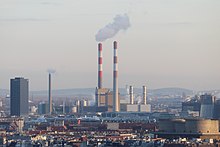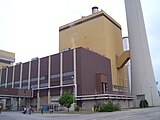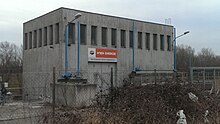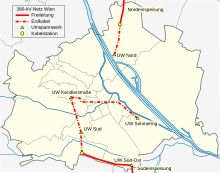Simmering power plant
The Simmering power plant is - overall - the largest power plant in Austria and provides electrical energy and district heating . It is located in Vienna's 11th district of Simmering and is operated by Wien Energie . The power plant is a so-called combined heat and power plant which consists of several independent power plant blocks, which can be fired with various primary energy sources such as natural gas , heating oil and biomass . Under full load, it can cover around 50% of Vienna's energy needs. The Simmering substation is also located on the site .
The power plant is by generating sets for own needs by means of diesel engines, even after a complete power failure black bootable .
history

On the basis of a municipal council resolution of May 11, 1900 to build a power plant in Simmering "for the delivery of electricity for the operation of the electric trams and for the delivery of light and power" , the first Viennese steam or heating power plant was built (at that time the company "Municipality of Vienna - Municipal Electricity Works "belonging). The busbar power plant consisting of the two related blocks 1 and 2 was put into operation almost two years later. In April 1902, the power station supplied electricity for the Vienna trams for the first time , and households were also supplied with electricity from September 1902. Coal was initially used to fire the boilers, crude oil from 1920 and natural gas from 1934/1935.
Towards the end of the Second World War , the power plant was badly damaged by bombs and artillery attacks, and in April 1945 operations had to be stopped for around ten days. In the post-war period, Unit 2 was shut down and dismantled, but Unit 1 was expanded from 1959 to 1964. In addition, due to the increasing demand for electricity, the power plant blocks Block 3 (1962), Block 4 (1964), Block 5 (1967) and Block 6 (1970) were built. Block 1 was shut down in 1977.
From 1977/78, units 1 and 2 also supplied district heating for the first time . The older units 3 and 6 were closed in 1992. Power plant units 4 and 5 were shut down between 1993 and 1997. The new power plant unit 3 was built on the area of the old Unit 3 and Unit 4. The demolition of units 5 and 6 began at the end of July 2009. A remote-controlled excavator is used for the approximately 200-meter-high chimney of block 6, which expands on the inner walls of the chimney, is steered remotely from a platform on the outside and "nibbles" the chimney from above. The rubble falls down inside. The chimney should be removed in this way in about 100 days. It was not possible to blow up the chimney because there was not enough fall space available. The second chimney is then demolished in the same way and the power plant units 5 and 6 are also removed. From 2010 the new block 4 is to be built on the site.
Active power plant units
Block 1 and 2
By autumn 2008, block power plant 2, which previously consisted of gas turbine 2, was modernized as combined block 1/2. It was expanded to include two newly built gas turbines and a steam turbine. The modernization carried out under the title “ Repowering BKW 1/2” was completed with the commissioning of the entire system in May 2009. After revision, block 2 serves as a reserve block and to cover peak loads. The renovation work was funded by investment subsidies in accordance with Section 24 ff of the Green Electricity Act 2012.
Unit 1 has a maximum output of 700 MW electrically and 450 MW thermally for district heating extraction. Unit 2 serves as a reserve unit with a maximum electrical output of 60 MW and caloric 150 MW. The direct connection to the 400 kV level in the neighboring substation is made via three block transformers.
The chimney of block 2 is 200 meters high and conical.
- Block 1/2
Block 3
Block 3 is the oldest block currently in operation, which is designed as a CCGT . The block is the only block in the plant that can be fired with difficulty using both natural gas and heating oil . The use depends on the respective availability, especially in winter when there is a high demand for natural gas, heating oil is sometimes used. A flue gas desulphurisation system , which produces 7 t of gypsum per hour , is available for exhaust gas cleaning .
The power in condensation operation is a maximum of 440 MW electrical and with district heating extraction a maximum of 380 MW electrical and 200 MW thermal. The direct connection to the 400 kV level in the neighboring substation is made via three block transformers.
The chimney of block 3 is 200 meters high.
- Block 3
Turbine set with steam turbine, under revision
Biomass power plant
On October 20, 2006, Europe's largest biomass power plant was put into operation as an independent unit. Primary wood waste (forest chips) is burned in it. With a simultaneous delivery of 37 MW of district heating, it can deliver 16 MW of electrical power; in condensation operation without district heating, the maximum electrical power is 24.5 MW. The steam turbine, a Siemens SST-400, works with reheating and achieves an electrical efficiency of 36% in summer operation (without steam extraction).
This power plant unit generates electricity (and district heating) from the renewable energy source wood. Its much lower yield compared to oil and gas blocks with similar space requirements is due to the lower calorific value / calorific value of wood, a more complicated combustion - in a circulating fluidized bed with quartz sand, and a higher proportion of ash that has to be separated. The cylindrical chimney of the biomass power plant is only 120 meters high and made of reinforced concrete rings.
In 2013, Europe's first high-pressure, high-temperature storage facility for heat was built in the form of two 45 m high tanks, in which typically 2200 hours a year of heat (145,000 MWh ) can be stored and withdrawn for just as long to replace the start-up of typically gas-powered peak load boilers . The pressure at the top of the tank is 6 bar, at the bottom 10 bar, the maximum water temperature is 150 ° C. With an investment of 20 million euros, it is possible to generate a higher proportion of the district heating requirement from wood in a CO2-neutral manner.
Standstill in 2019
In August 2019, the power plant was shut down because the federal government no longer received any funding for the burning of biomass. The then turquoise-blue government had not adopted a successor regulation to the Green Electricity Act for solid biomass and had resigned. A succession regulation by means of the Viennese provincial law is in preparation, so that a restart at the beginning of 2020 appears possible. There is enough wood waste from nearby forests. A company without funding is not economical.
- Biomass power plant
Block 4 (draft)
The construction of Unit 4 was planned on the site of the former Unit 5 and Unit 6. It was planned as a combined cycle plant and should be able to deliver a maximum electrical output of 450 MW in condensation mode and a maximum electrical output of 410 MW and 200 MW district heating when operated with district heating extraction. According to the current state of knowledge, the realization of Unit 4 is not intended under the current market conditions.
Outlet turbine of the Simmering power plant
The power house of the outlet turbine of the Simmering power plant is structurally separated from the power plant between the Danube Canal and the direction of the east highway leading to Hungary and the Simmeringer Lände. It is connected to the “main building” via a non-public pedestrian bridge.
The built in 1964, 14 x 8 meters wide and flat-roofed nacelle houses one of the Maschinenfabrik Andritz Actiengesellschaft prepared Kaplan turbine with a power of 553 kilowatts. A part of the cooling water return from the block power plants 1, 2 and 3 into the Danube Canal is used and recovers part of the previously provided pumping capacity.
Substation
The Simmering substation consists of a closed construction of a 400 kV and 110 kV level. The switchgear has a compact design as gas-insulated switchgear . The 110 kV SF6 switchgear was put into operation in October 2008 and is the largest gas-insulated switchgear in the Wiener Netze distribution network . Several substations are supplied via the 110 kV level. During normal operation, the substation, like all substations of Wiener Netze, is remotely controlled by the load distributor from the “Smart Campus” of Wiener Netze.
On the substation premises there are several power transformers for supplying the medium voltage level operated with 10 kV , two Petersen coils for earth fault compensation and 4 coupling transformers for the 400 kV level. The 400-kV level, except for the biomass power plant, all the power plant units are connected to the, has for better energy distribution in the urban area, a 400-kV underground cable connection across Vienna to the west in Ottakring located substation Kendlergasse and from there to the substation South (Vienna ) .
- 110 kV SF6 switchgear
Detail view of an element from behind. In the center of the picture in the vertical cylinder the circuit breaker , on the right the outgoing disconnector. Behind the two horizontally running busbars and between the busbar disconnectors.
literature
- Br (uno) Böhm-Raffay: Implemented and projected systems. Austria. The Electricity Works of the City of Vienna . In: Ludwig Kusminsky (Red.): Journal for electrical engineering . Volume 19.1901, issue No. 33/1901, ISSN 1013-5111 . Spielhagen & Schurich ( Commission ), Vienna 1901, p. 406 f.
Web links
- Wien Energie
- Description of the Simmering power plant ( Memento from June 8, 2008 in the Internet Archive )
- The forest biomass power plant in detail
Individual evidence
- ↑ a b Michael Heinrici: Repowering Simmering BKW 1/2 (PDF; 2.9 MB) ( Memento of the original from January 20, 2010 in the Internet Archive ) Info: The archive link was inserted automatically and has not yet been checked. Please check the original and archive link according to the instructions and then remove this notice. . In: gaswaerme.at . Wien-Energie, Lecture FGW, Vienna 2009, accessed on February 13, 2013.
- ↑ Wien Energie puts a highly efficient power plant into operation with “Kraftwerk Simmering 1” ( page no longer available , search in web archives ) Info: The link was automatically marked as defective. Please check the link according to the instructions and then remove this notice. . In: eubusiness.at , May 25, 2009, accessed on February 13, 2013.
- ↑ Investment funding for CHP plants oem-ag.at, 7 January 2002.
- ↑ Friedrich Pink: Use of renewable energy sources by Wien Energie Wienstrom (PDF; 1.1 MB) ( page no longer available , search in web archives ) Info: The link was automatically marked as defective. Please check the link according to the instructions and then remove this notice. . Lecture Wien-Strom, Vienna 2007, accessed on February 13, 2013.
- ↑ StadtUNknown: Simmering Forest Biomass Power Plant wien.gv.at, 2016, accessed October 17, 2019.
- ↑ Power generation in Vienna ( Memento of the original from October 9, 2014 in the Internet Archive ) Info: The archive link was automatically inserted and not yet checked. Please check the original and archive link according to the instructions and then remove this notice. . In: wien.gv.at , accessed on February 13, 2013.
- ↑ Technical data ( Memento of the original from February 13, 2013 in the Internet Archive ) Info: The archive link was automatically inserted and not yet checked. Please check the original and archive link according to the instructions and then remove this notice. , accessed February 16, 2013.
- ↑ The world's first high-pressure heat storage system in Simmering wien.gv.at, July 20, 2012, accessed October 17, 2019. - Video (2:43)
- ↑ Economy: Biomass power plant to go back into operation orf.at, October 17, 2019, accessed October 17, 2019.
- ↑ Brief description of block 4 according to § 17 UVP-G 2000 ( page no longer available , search in web archives ) Info: The link was automatically marked as defective. Please check the link according to the instructions and then remove this notice.
- ↑ Dipl.-Ing. Valentin Weber-Ille: Architecture of hydropower plants in Austria (Dissertation, Vienna, April 2013)
- ↑ Smart Campus of Wiener Netze. In: wien.gv.at. Retrieved July 11, 2020 .
- ↑ The history of Wien Strom. ( Memento of January 4, 2011 in the Internet Archive ) Vienna 2010, accessed via waybackmachine on February 13, 2013.
Coordinates: 48 ° 10 ′ 53 ″ N , 16 ° 26 ′ 2 ″ E









